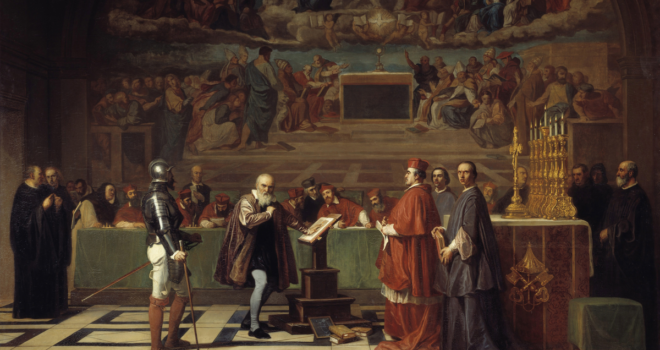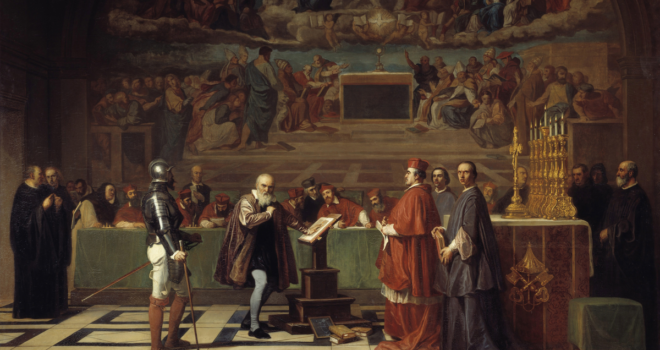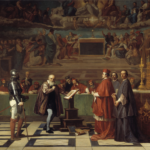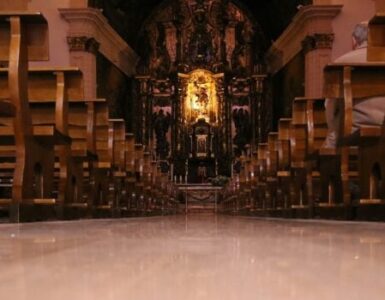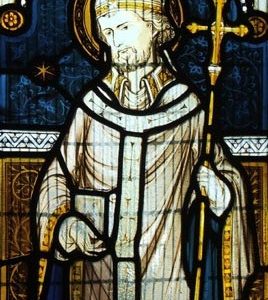This April is the 390th anniversary of the famous Galileo trial, commenced in Rome in 1633 and held over three sessions between April 12 and May 10, with his verdict delivered on June 22. The Galileo case has become an unfortunate symbol of the alleged clash between religion and science. For many, it is an emblem of the Church’s “hostility” to scientific progress.
Galileo, of course, is known for promulgating the Copernican system that the earth and planets rotate around the sun, which at the time was a controversial theory. The framing of this case as a conflict between religion and science is woefully simplistic, and the portrayal of the Church as “anti-science” is completely unfounded. Astronomers who questioned Galileo’s theories did so not because of religious bias, but because they were not convinced of the science behind heliocentrism. The Church, following the scientific consensus of the day, considered the total revolutionizing of cosmology to be rash and was hesitant to embrace the new theories unless they could be more conclusively demonstrated.
The story of Galileo’s conflict with the Church is a long and complex one that we do not have the space to cover here. Rather, we shall look at common points of misinformation that are repeated about Galileo. The Galileo story has given rise to many persistent myths—tales with no grounding in history serving only to sensationalize the story to make the Church’s attitude towards Galileo seem much harsher than it was.
Myth 1: Cardinals Were Afraid to Look Through Galileo’s Telescope
In 1611, Galileo came to Rome and set his new telescope up in the gardens of Cardinal Barberini on the Quirinal Hill. Here he demonstrated the existence of sunspots, craters on the moon, satellites around Jupiter, and other heavenly marvels hitherto unknown.
There is a persistent legend that one skeptical cardinal, when asked to look through the telescope, refused, saying, “I am afraid of what I might see!” The implication here is that the cardinal was willing to ignore scientific truth in order to maintain religious orthodoxy.
There is no evidence that anyone refused to look through Galileo’s telescope when offered the chance. The myth seems to be based on two quotes, one from philosopher Cesare Cremonini, the other from Galileo himself.
Cremonini had looked through earlier versions of the telescope and found the vision blurry—so blurred, in fact, that the experience left him with a headache. As one of the few men in Europe who had actually looked through a telescope at the time, Cremonini was bombarded with questions about Galileo’s claims. Cremonini was exasperated by the chatter about the telescope and said, “I do not wish to approve of claims about which I do not have any knowledge, and things about which I have not seen”—in other words, though he had looked through the telescope, he could neither confirm nor deny what Galileo claimed. “To observe through those glasses gives me a headache,” he continued. “Enough! I do not want to hear anything more about this.”[1] Cremonini was not refusing to look through Galileo’s telescope; he was expressing frustration at the number of inquiries he was receiving on the matter and was tired of talking about it.
The second pertinent quote is from Galileo himself. After Galileo announced the discovery of moons around Jupiter, another philosopher—Giulio Libri of Pisa—attempted to see them for himself. However, as Libri used an inferior telescope, he was unable to observe them. When Libri died shortly afterward, Galileo sarcastically said, “Never having wanted to see [the moons of Jupiter] on earth, perhaps he’ll see them on the way to heaven.”[2] The statement is incredibly unfair to Libri. There is no evidence he did not want to see the moons of Jupiter; he tried to see them but simply couldn’t because his telescope was not as good as Galileo’s.
No one we know of declined to look through the telescope, even if they did argue about what they saw.
Myth 2: Galileo Was Tortured by the Inquisition
Ever since the time of Galileo there have been stories that the astronomer was tortured or even blinded by the Inquisition. Galileo was not tortured, however, and was certainly not blinded.
During his trial, on June 21, Galileo was reminded by the Inquisitors that the law permitted them to use torture to obtain a confession. This was not necessary, however, as Galileo submitted to the Church’s judgment voluntarily and agreed to whatever penance was imposed. This was the only time torture was ever mentioned during his trial.
Regarding Galileo being blinded, he did in fact go blind around 1637, four years after the trial and five years before his death. Galileo’s blindness in old age may have contributed to the legend that he was blinded by the Inquisition.
Galileo was not physically harmed in any way during his trial or afterward.
Myth 3: Galileo Was Condemned as a Heretic
Most people assume that Galileo was condemned as a heretic for teaching that the earth was not the center of the solar system. This is untrue. Copernicanism was not considered a heresy per se; it was considered an unproven scientific theory that the Church prohibited from being taught as fact until further evidence was forthcoming proving it to be so. Pope Urban VIII (r. 1623-1644) had even told Galileo that he was fine with the latter teaching Copernicanism so long as it was taught as a hypothesis and not reality. It was Galileo’s disregard for this directive—and the public insults leveled at the pope in his book Dialogue Concerning the Two Chief World Systems—that got Galileo in trouble.
In the end, the Inquisition did not condemn Galileo as a heretic, but rather judged him “suspected of heresy,” which was a considerably lesser judgment than heretic. Like Copernicus before him, Galileo died in union with the Church; in fact, the pope sent an envoy to give him a special blessing as he lay dying. Galileo was buried with the full rites of the Church in the church of Sante Croce in Florence.
Myth 4: Galileo Said, “And Yet It Moves!”
One of the most oft repeated myths about Galileo is that, after being forced to abjure Copernicanism by the Inquisition, he muttered the phrase Eppur si muove! (“And yet it moves!”), a reference to the motion of the earth in the Copernican system.
There is no evidence Galileo ever uttered this. The phrase is not found in any work of Galileo, nor attested by anyone who knew him or any eyewitnesses to his trial. Nor do the earliest biographies written after Galileo’s death mention it. It is not attested until 1757 in a book by Giuseppe Baretti called Italian Library. Baretti wrote:
The moment he was set at liberty, he looked up to the sky and down to the ground, and, stamping with his foot, in a contemplative mood, said, Eppur si muove, that is, still it moves, meaning the Earth.[3]
It is unclear where Baretti got his information, but the book is full of many other falsehoods (that Galileo was imprisoned for six years by the Inquisition, that he was tortured, etc). Printed, as it was, 125 years after the trial, this could hardly have been first-hand information. It was likely a literary embellishment on the part of Baretti.
The phrase was also discovered on a portrait of Galileo that some attribute to the 17th century Spanish artist Bartolomé Esteban Murillo, but there is considerable controversy about the work, with many claiming it dates from the 19th century.
Whatever the origin of the phrase, there is no evidence it was uttered by Galileo.
Myth 5: Galileo Was Imprisoned
The Murillo painting mentioned above depicts Galileo in a dank prison cell, a captive of the cruel Inquisition.
Galileo was never imprisoned by the Inquisition, however. During his trial he was lodged in spacious apartments in Rome. It is true that his initial trial sentence was life imprisonment, but this was immediately commuted to house arrest with the order to pray the penitential psalms once a week for three years.
Galileo spent the rest of his life in Florence under house arrest, but we should not consider this as analogous to house arrest today, where an offender must literally stay indoors banded with an electronic tether. Galileo lived in a luxurious villa in Florence, so he was certainly not subsisting in a poor state. Furthermore, he was not prohibited from moving about his hometown, staying with friends, or living a normal life. “House arrest” essentially meant he was not to leave Florence. Given that Galileo was already elderly (he was 69 years old at the time of his trial), how much traveling abroad did he really intend to do anyway?
Conclusion
The conflict between Galileo and the Church was unfortunate. The Church was ever Europe’s most devoted patron of science; that it should have a dispute with one of Europe’s most brilliant scientists is tragic. But we need not make more of the affair than it was. Galileo was no victim of clerical authoritarianism, nor was his theory resisted because of ignorant religious fundamentalism. The truth of the Galileo case is significantly less exciting than we have been led to believe.
[1] James Hannam, The Genesis of Science (Washington D.C: Regnery Publishing, 2011), 318
[2] Ibid, 319
[3] Giuseppe Baretti, The Italian Library, in The Strand (London, 1757), pg. 52
Image: Galileo Before the Holy Office by Joseph-Nicolas Robert-Fleury, 1847. Public domain.


